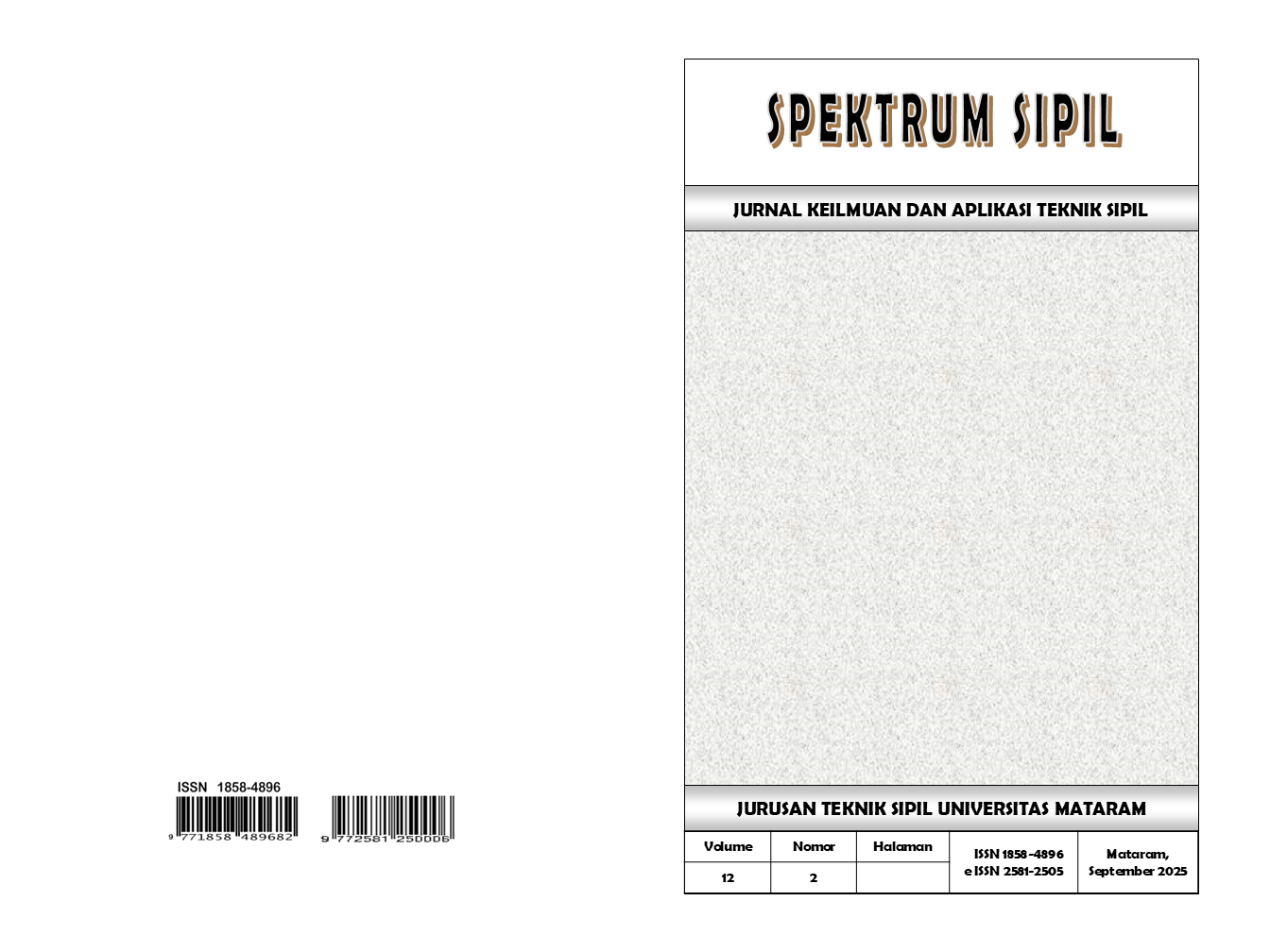EVALUASI DEBIT PUNCAK BANJIR RANCANGAN DENGAN METODE WEDUWEN, HASPERS, MELCHIOR, NAKAYASU DAN GAMA 1 PADA DAS CABANG
Evaluation of Design Flood Peak Discharge using the Weduwen, Haspers, Melchior, Nakayasu and Gama-1 Methods in Cabang Watershed
DOI:
10.29303/spektrum.v12i2.391Published:
2025-10-20Issue:
Vol. 12 No. 2 (2025): SPEKTRUM SIPILKeywords:
Weduwen, Melchior, Harspers, Nakayasu, Gama 1, Debit rancanganArticles
Downloads
How to Cite
Downloads
Abstract
Analisis debit puncak banjir sangat diperlukan dalam perencanan bangunan air. Penentuan
debit puncak banjir yang tepat akan menghasilkan dimensi bangunan air yang lebih efektif
dan ekonomis. Studi ini menguji keakuratan metode Weduwen, Haspers, Melchior,
Nakayasu, dan Gama 1 dalam menghasilkan debit banjir rancangan yang sesuai untuk DAS
Cabang. Data karakteristik DAS dibutuhkan untuk memperkirakan besarnya debit puncak
banjir rancangan yang kemudian akan dibandingkan terhadap debit banjir observasi data
debit. Berdasarkan hasil analisis didapatkan besar debit banjir rancangan yang beragam
dengan metode Weduwen, Melchior, Haspers, Nakayasu dan Gama 1 menghasilkan debit
puncak banjir periode ulang 100 tahun yakni : Weduwen = 451,073 m³/dtk, Haspers =
160,964 m³/dtk, Melchior = 990,711 m³/dtk, Nakayassu = 512,631 m³/dtk, dan Gama 1 =
633,333 m3/dtk. sedangkan debit banjir observasi adalah 156,921 m³/dtk. Berdasarkan
evaluasi kelima metode, Haspers menghasilkan debit banjir rancangan yang paling
mendekati debit banjir observasi segabai nilai yang menjadi acuan. Dengan nilai statistik
terkecil yakni : VE = 31,581 %, RE = 6,161 %, dan RMS = 12,260. Adapun metode Melchior
dan metode Hidrograf Gama 1 kurang andal jika digunakan pada DAS Cabang.
References
Adoe, D, P. Sina, D, A, T. & Krisnayanti, D, S. (2021). Analisis Debit Banjir Pada DAS Di pulau Sumba dengan Metode Hss Nakayasu an Hss Gama-1. Jurnal Teknik Sumber Daya Air. 1(1), 11-20. https://jtsda.hathi.id/index.php/jtsda/article/view/6.
Balai Besar Wilayah Sungai Nusa 1. (2023). Data dan Informasi Pengelolaan Sumber Daya Air Wilayah Sungai Lombok dan Wilayah Sungai Sumbawa. Mataram.
Direktorat Jendral Sumber Daya Air. (2013). Perencanaan Jaringan Irigasi KP-01. Jakarta: kementrian pekerjaan umum.
Harto, S. (1993). Analisa Hidrologi. Gramedia Pustaka Utama.
Kamiana, I. M. (2011). Teknik Perhitungan Debit Rencana Bangunan Air. Yogyakarta: Graha Ilmu.
Saidah, H. Pracoyo, A. & Khairudin, K. (2020). Perbandingan Beberapa Metode Perhitungan Debit Puncak Banjir Rancangan. Ganec Swara. 14(1), 526-536. DOI:10.35327/gara.v14i1.130.
Soemarto, C. D. (1987). Hidrologi Teknik. Surabaya: Usaha Nasional.
Soewarno. (1995). Hidrologi, Aplikasi Metode Statistik untuk Analisa Data. Bandung: Nova.
Sujendra. I Nengah Eka, Yamin, M. & Aminullah. (2024). Analisa Debit Rencana Bendung Jangkok. Al Aqlu, Jurnal Matematika, Teknik dan Sains. 2(2), 93-102. https://doi.org/10.59896/aqlu.v2i2.97.
Suripin. (2004). Sistem Drainase Perkotaan yang Berkelanjutan. Yogyakarta: Andi Offset.
Triatmodjo, B. (2008). Hidrologi Terapan. Yogyakarta: Beta Offset.
Author Biographies
Gilang Zulfa Akbari, Universitas Mataram
I Wayan Yasa, Universitas Mataram
Humairo Saidah, Universitas Mataram
License
Copyright (c) 2025 Gilang Zulfa Akbari, I Wayan Yasa, Humairo Saidah

This work is licensed under a Creative Commons Attribution 4.0 International License.
You are free to:
- Share — copy and redistribute the material in any medium or format for any purpose, even commercially.
- Adapt — remix, transform, and build upon the material for any purpose, even commercially.
The licensor cannot revoke these freedoms as long as you follow the license terms.
Under the following terms:
- Attribution — You must give appropriate credit, provide a link to the license, and indicate if changes were made. You may do so in any reasonable manner, but not in any way that suggests the licensor endorses you or your use.
- No additional restrictions — You may not apply legal terms or technological measures that legally restrict others from doing anything the license permits.
Notices:
You do not have to comply with the license for elements of the material in the public domain or where your use is permitted by an applicable exception or limitation.
No warranties are given. The license may not give you all of the permissions necessary for your intended use. For example, other rights such as publicity, privacy, or moral rights may limit how you use the material.












